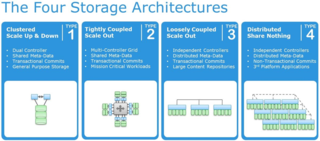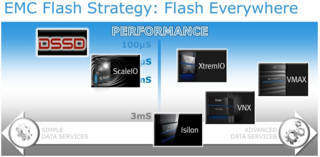Redefine Flash! EMCs Flash Strategy is Flash Everywhere, and architecture matters!
Architecture Matters and Storage Architecture has mattered since the first ICDA (Integrated Cache Disk Array) was introduced by EMC in 1990, The Symmetrix 4200 ICDA. It’s interesting to watch the storage industry. New start-ups all claim to have some whiz-bang technology that promises to change everything. Take a minute, step back, take a closer look. They are all rooted in one of the four traditional storage architectures.
Check out Chads detaled review of all four architectures here.
A fundamental understanding of storage architectures, and their pros/cons, will help you map the right architecture to YOUR application needs. The architecture conversation has always been the most relevant overarching storage concept, and it’s one you need to understand.
In fact, the conversation is so important EMC dedicated an entire General Session of EMCWorld 2014 to architectures. Area 52 covered the four “traditional” storage architectures and the concept of a fifth emerging architecture, In-Memory IO. I won’t get into the details here, but direct you to “Virtual EMCWorld 2014” replay of Area52, complete with architecture overviews and demonstrations as only “Chad” can deliver. (Click Technical Session and more, then look for Area 52) Don’t restrict yourself to thinking of these architectures as hardware. They can be presented as hardware and/or software, they still share one of the core architecture types.
Yes, Architectures Matters, but what does that have to do with “Flash”? Let’s step back a second. What is “Flash”? In its simplest form, Flash is storage media, fundamentally different than traditional spinning disks. Yes, there are different types of Flash, much like there are different types of spinning disks, all with different capacity, performance and price points. The evolution of each of which will continue. Flash will get faster, denser & cheaper. Spinning disks will continue to get bigger, but performance of spinning disk has hit a physical limit of 15K RPM. You just can’t spin them any faster without jeopardizing data integrity, that’s exactly why Flash is so important today.
So the obvious question is “What’s the best enterprise storage architecture for Flash?” If you’ve been in IT for any amount of time, you know the answer… “It depends”. The follow up question should always be “What’s your workload (Service Level)?”
Flash impacts EVERY storage architecture, and that’s exactly why the EMCs Flash Strategy is “Flash Everywhere”. The key is how Flash is used to impact your application or applications.
By creating a Storage Portfolio that spans every service level, EMC is in a unique position to integrate Flash technologies across all storage workloads. If there was a single product, guess what, it would fix everything… or that’s how it would be positioned. By having a portfolio, EMC can look at your problem and recommend the appropriate solution.
Though not specifically called out, an underlying theme of the recent Mega Launch (ML4) was “Flash Everywhere”.
XtremIO 3.0 highlights what’s possible with a scale-out architecture that’s purpose built for Flash, all Flash all the time. Sure XtremIO is fast, it always has been, but XtremIO 3.0 is all about additional always on, in-memory, in-line data services. Compression, on top of existing deduplication, D@RE (data at rest encryption), space efficient snap-shots all with Flash specific data protection (XDP), and everything thin provisioned all the time!
Isilon SmartFlash leverages up to 1PB of Flash as a caching pool to increase performance across every node in the loosely-coupled scale-out architecture, specifically designed for file services. VMAX3 leverages Flash seamlessly with its Service Level Oriented approach, taking FAST (Fully Automated Storage Tiering) to the next level. VMAX3 allows a user to hyper consolidate workloads, while identifying specific service levels for each application. Looking for sub millisecond response time, the Diamond Tier will do the trick, and under the covers your data lives on Flash. The VMAX3 Gold Level is perfectly capable of delivering response times of a few milliseconds, and some of your data will live on Flash.
That really brings us full circle, back to your applications and your workloads! That’s what really matters! Flash enables architectures that enable your applications. For more on EMCs full Flash Product offering, visit the EMC “Redefine Flash” page.
As always, follow me on twitter @SamMarraccini, check out my YouTube channel and if you are headed to VMWorld2014 (San Fran), drop me a tweet and be sure to stop by the EMC Booth!


